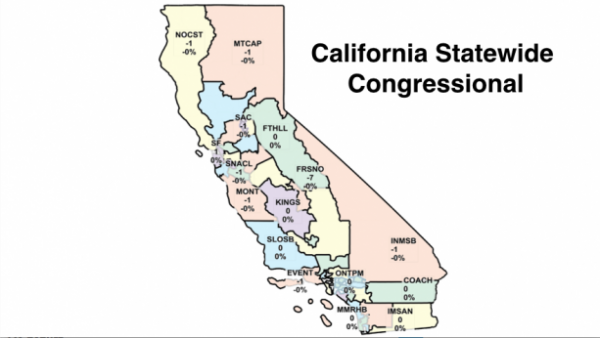An effort by a newly announced coalition supporting California’s redistricting commission may run into some harsh political realities in its quest to keep current congressional lines in place if the United States Supreme Court throws out redistricting commissions in the Arizona State Legislature vs. Arizona Independent Redistricting Commission case.
Californians supported two initiatives that took the power of drawing legislative district lines away from elected officials and turned that power over to an independent commission. Proposition 11 in 2008 created the Independent Citizens Redistricting Commission to draw state government district lines; Proposition 20 in 2010 added to the Commission’s responsibility drawing congressional districts. The latter measure is the one threatened by the Arizona case.
Arizona legislators point to the United States Constitution, Article I, Section 4 that declares, “The Times, Places, and Manner of holding Elections for Senators and Representatives, shall be prescribed in each State by the Legislature thereof.”
The case was heard before the Supreme Court earlier this month with the decision slated for sometime in the summer. Speculating on this site at the possible outcome after analyzing the questions asked by the justices during the hearing, political analyst Tony Quinn thought the justices would throw out the redistricting commission; Kathay Feng of Common Cause was not so sure.
Feng is part of the coalition, Hold Politicians Accountable, that is demanding that the legislators leave the districts in place if the redistricting commission lines are dissolved by the court. Feng said, “California’s elections face a grim future” if the court “sides with the politicians.”
Chatter around the capitol suggests that the Democratic majorities plan to leave the district lines unchanged until the next census although none of the legislative leaders have made any such clear-cut declarations. In the political world of Sacramento it is hard to imagine that a hands-off policy would last more than one election cycle, if that.
There are seats to be gained or at least made safe for Democratic majority members. Tony Quinn pointed to a number of examples of how the Democrats might reshuffle the districts in his piece linked above.
But, there is another player in this redistricting game. The governor of California has a role. Jerry Brown can veto any redistricting plan that comes out of the legislature. That only increases the governor’s power to leverage the process. It gives him influence over issues of concern in California that are directly connected to Washington.
For instance, would new majority leader Kevin McCarthy’s seat be in danger or will he and other members of congress feel pressure to deal with Brown on his concerns? McCarthy has been odds with the governor over a number of issues, especially funding for the governor’s pet project, the High Speed Rail.
While the new Hold Politicians Accountable coalition can make demands and keep a spotlight on the redistricting process if the court sides with the Arizona Legislature, in the short term before the coalition could do another ballot measure that might satisfy the court, all the cards will be held by the politicians and they may have a few aces up their sleeves they plan to play.


